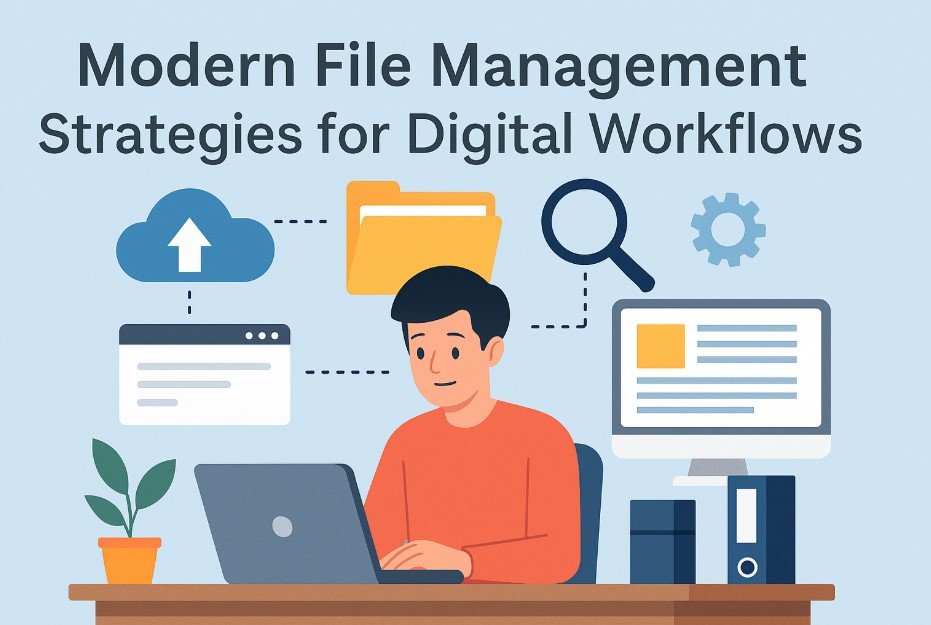Tech
Modern File Management Strategies for Digital Workflows

In the current digital transformation era, organizations face immense challenges in managing skyrocketing volumes of information while maintaining high productivity and seamless collaboration. Successful file management now means far more than simply storing documents; it forms the bedrock of efficient workflows, robust data security, and a nimble, adaptable workforce. By adopting comprehensive corporate entity management solutions, businesses can streamline their document organization processes while ensuring compliance with and adherence to regulatory standards. Such solutions simplify file handling and tracking and empower teams to remain agile, foster innovation, and support business growth. Integrating cutting-edge file management strategies is now synonymous with achieving operational excellence and ensuring long-term business sustainability even in an environment of rapidly changing technology and threats.
As digital transformation rapidly becomes a strategic mandate across industries, embracing forward-thinking file management practices is paramount for minimizing operational risks, speeding up access to vital information, and fostering transparent, data-driven decision-making. This guide explores a comprehensive set of actionable strategies tailored to organizations intent on staying competitive and secure, no matter how complex or evolving the digital landscape. From leveraging artificial intelligence and cloud technologies to embedding compliance automation and sustainability, these approaches equip business leaders and IT managers with the knowledge to optimize digital workflows at every level.
AI-Driven Document Automation
Artificial Intelligence (AI) is fundamentally reshaping how businesses approach file management. No longer restricted to basic filing or sorting, AI now automates complex, repetitive tasks such as data extraction, intelligent classification, document indexing, and workflow routing. Modern machine learning algorithms can analyze vast unstructured data stores—including scanned physical documents, emails, and multimedia files—identifying patterns and categorizing files with precision and consistency far exceeding manual efforts.
How AI Improves Accuracy and Efficiency
By deploying AI-driven document automation, businesses can drastically reduce human errors that have traditionally plagued manual documentation processes. This shift ensures the creation of reliable, easily auditable records and liberates human staff to focus on higher-value, strategic tasks. AI-powered tools can, for example, automatically extract relevant information from invoices, contracts, and receipts, negating the need for repetitive data entry. Furthermore, as AI systems learn from historical data, they become adept at identifying workflow bottlenecks, automatically rerouting documents, or triggering alerts when deadlines are at risk, consistently ensuring resource optimization and adherence to project timelines.
Real-World Impact
Organizations that have implemented AI-enabled document management consistently report significant gains. Many have witnessed up to a 50% reduction in document processing times, improved compliance capabilities, and heightened accuracy in data handling. Intelligent automation directly contributes to minimizing compliance risks and supports a culture of rapid, confident, and consistent decision-making, lending companies a critical, scalable advantage in fast-moving industries. For forward-thinking businesses, investing in AI solutions means staying future-ready and gaining a robust foothold in an AI-driven economic landscape.
Cloud-Based Solutions
Cloud-based file management platforms have revolutionized how teams store, access, and collaborate on documents, liberating organizations from the constraints of on-premise infrastructure. With cloud solutions, employees and stakeholders can view, edit, and share documents securely from anywhere in the world, on any device. This is particularly critical as remote and hybrid work models become the standard across industries.
Scalability and Business Continuity
Scalability is one of the most compelling benefits of cloud-based solutions. Rather than investing in costly physical hardware that can quickly become obsolete, businesses can expand storage capacity and app functionality as needs evolve by adjusting their subscriptions. Cloud file management also underpins business continuity by providing automated, redundant backups, safeguarding against on-site disasters or data loss. Real-time collaboration features such as simultaneous editing and automatic version control foster strong teamwork and ensure every team member is working on the latest, most accurate version, eliminating data silos and confusion.
Enabling Agile Workforces
Robust cloud platforms empower organizations to respond to changing market demands or client requirements, all while ensuring central oversight and governance. Advanced platforms provide granular, role-based access controls to ensure that confidential files are always secure, and collaborative digital workspaces make it easy to coordinate projects and maintain organized workflows. Adopting cloud file management is not just a choice; staying agile and competitive in a mobile, distributed workforce landscape is necessary.
Enhanced Security Measures
With cyber threats escalating in frequency and sophistication, every organization must treat robust file security as a top priority. The sheer volume and sensitivity of the digital data handled by modern businesses—ranging from intellectual property to personal customer details—mean the consequences of a breach can be catastrophic. As a result, comprehensive protection strategies are no longer optional but core requirements in contemporary file management frameworks.
Key Security Features
- End-to-end encryption:This secures every file from its point of storage to when it’s accessed or transmitted, ensuring that even if intercepted, the data remains unreadable by unauthorized parties.
- Multi-factor authentication (MFA):By requiring users to verify their identity through multiple channels—such as biometrics, SMS codes, or authenticator apps—MFA substantially reduces the risk of unauthorized access even if user credentials are compromised.
- AI-driven anomaly detection:Modern file management systems now leverage artificial intelligence to monitor user behavior and system activity in real time, automatically flagging or blocking suspicious actions to minimize the impact of data breaches or insider threats.
Implementing such advanced security features creates a foundational layer of trust for internal stakeholders and clients while helping organizations meet the stringent data protection regulations that define today’s business environment.
Seamless Integrations
The true power of modern file management is unlocked when it seamlessly integrates with essential business platforms, such as customer relationship management (CRM) systems, enterprise resource planning (ERP) suites, and core accounting software. Rather than operating as isolated silos, interconnected platforms allow organizations to synchronize data, reduce errors, and streamline processes, delivering significant time savings and sharper competitive performance.
Connecting the Digital Workplace
Seamless integration fosters a unified digital workplace by automating data flow between disparate systems. For instance, when legal contracts or onboarding forms are linked directly with employee profiles in HR platforms or when client documents are instantly accessible within a sales team’s CRM dashboard, processes are not only accelerated but also made more accurate and transparent. Finance departments benefit from real-time invoice and payment tracking updates, enabling smarter budget and cash flow management.
Reducing Friction and Redundancy
Blending systems eliminates the friction of redundant data entry and reduces the risk of population inconsistencies. It directly supports regulatory compliance and creates a clear audit trail for all business activities. Integration should be a fundamental priority for any organization seeking to build a scalable, resilient digital infrastructure—one ready to embrace future technologies as they emerge.
Mobile-First Accessibility
The boundaries between office-based and remote work are fading, making it imperative for employees to be able to access, manage, and share files securely on any device. Mobile-first file management systems are carefully designed to optimize user experience on smartphones and tablets, so key business operations—such as document editing, approvals, or signature collection—can be completed quickly and efficiently, regardless of location.
Productivity from Anywhere
Empowering teams with proper mobile access means faster response times to client, partner, or internal requests—even when staff are traveling or on-site with customers. Advanced mobile interfaces achieve the right balance of security and usability, often featuring biometric logins, intuitive navigation, and offline synchronization so critical files are available even in low-connectivity or no-connectivity scenarios. This level of productivity from anywhere is no longer a luxury but a necessity for organizations striving to maximize efficiency and keep pace with market demands.
Sustainability and Paperless Initiatives
Paperless workflows are becoming a fundamental requirement for companies as they prioritize environmental responsibility and operational efficiency. By replacing paper-based processes with digital alternatives, organizations can reduce their ecological footprint, minimize waste, cut supply and storage costs, and maintain nimble operations. Digital first processes also enhance corporate sustainability goals and public reputation.
-

 Social Media2 months ago
Social Media2 months agoWhat the “67” TikTok Meme Really Means
-

 Tech2 months ago
Tech2 months agoWhat To Do When Your Business Faces Network Vulnerabilities
-

 Self Improvement2 months ago
Self Improvement2 months agoUsing BCBS Rehab to Access Quality Addiction Care
-

 Games2 months ago
Games2 months agoPusoy Strategies for Play That Also Work in Pusoy Dos in English






